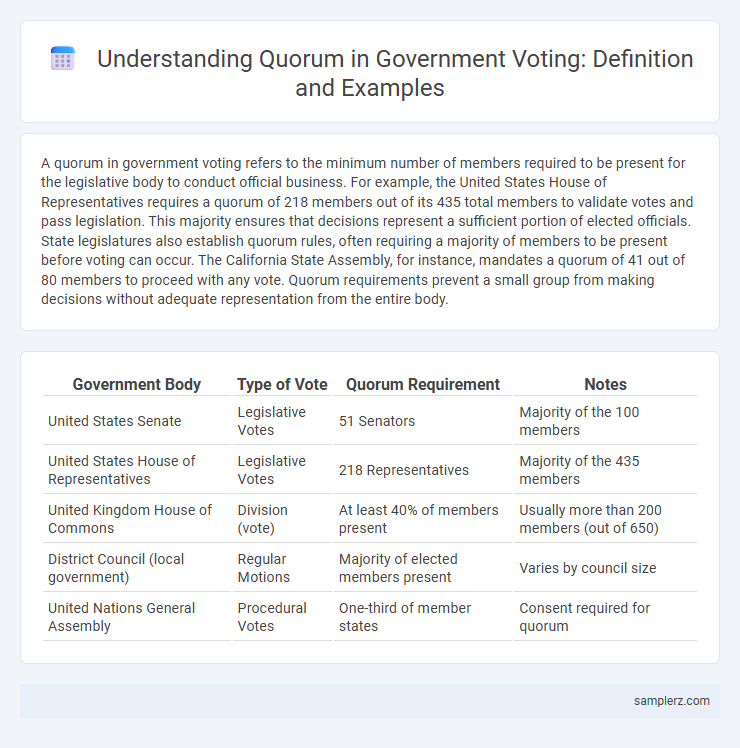A quorum in government voting refers to the minimum number of members required to be present for the legislative body to conduct official business. For example, the United States House of Representatives requires a quorum of 218 members out of its 435 total members to validate votes and pass legislation. This majority ensures that decisions represent a sufficient portion of elected officials. State legislatures also establish quorum rules, often requiring a majority of members to be present before voting can occur. The California State Assembly, for instance, mandates a quorum of 41 out of 80 members to proceed with any vote. Quorum requirements prevent a small group from making decisions without adequate representation from the entire body.
Table of Comparison
| Government Body | Type of Vote | Quorum Requirement | Notes |
|---|---|---|---|
| United States Senate | Legislative Votes | 51 Senators | Majority of the 100 members |
| United States House of Representatives | Legislative Votes | 218 Representatives | Majority of the 435 members |
| United Kingdom House of Commons | Division (vote) | At least 40% of members present | Usually more than 200 members (out of 650) |
| District Council (local government) | Regular Motions | Majority of elected members present | Varies by council size |
| United Nations General Assembly | Procedural Votes | One-third of member states | Consent required for quorum |
Definition of Quorum in Government Voting
Quorum in government voting is the minimum number of members required to be present for a legislative body to conduct official business and make decisions. This threshold ensures the legitimacy of the vote and prevents a small, unrepresentative group from making binding resolutions. For example, the United States House of Representatives requires a quorum of at least 218 members out of 435 to validate a vote.
Importance of Quorum for Legislative Procedures
A quorum in legislative voting is the minimum number of members required to be present to validate official decisions, often set by constitutional or parliamentary rules. Ensuring a quorum prevents decisions without adequate representation, thereby maintaining the legitimacy and accountability of legislative actions. Without a quorum, votes can be invalidated, disrupting the legislative process and undermining public trust in governmental procedures.
How Quorum is Determined in Different Governments
Quorum in voting procedures varies across governments, typically determined by constitutions or parliamentary rules specifying a minimum percentage or number of members required for valid decision-making. For instance, the U.S. House of Representatives requires a quorum of 218 members out of 435, ensuring majority presence before legislation. In contrast, the UK House of Commons sets a quorum at 40 members, reflecting different parliamentary traditions and sizes.
Historical Examples of Quorum in Parliamentary Votes
The 1642 English Parliament famously required a quorum of 40 members to convene and pass significant legislation during the lead-up to the English Civil War, illustrating early parliamentary quorum practices. In the United States Senate, a quorum of 51 senators is mandatory to conduct official business, a rule that has influenced numerous legislative processes since its establishment by the Constitution. The French National Assembly uses a quorum of one-third of its members to validate votes, a standard that has shaped the effectiveness of parliamentary decisions throughout modern French political history.
Quorum Requirements in Local Government Meetings
Quorum requirements in local government meetings typically mandate the presence of a majority of members, such as at least five out of nine city council members, to conduct official business and validate voting outcomes. This ensures decisions reflect a representative segment of elected officials, promoting transparency and accountability in municipal governance. Failure to meet quorum can result in the adjournment of sessions, delaying critical local policy and budget approvals.
Consequences of Failing to Meet Quorum
Failing to meet quorum in government voting sessions results in the inability to legally pass legislation or make binding decisions, which can stall legislative processes and delay policy implementation. This lack of quorum may lead to repeated adjournments, increased public frustration, and diminished trust in governmental effectiveness. Persistent quorum failures can undermine the legitimacy of the governing body and trigger calls for procedural reforms or changes in attendance requirements.
Notable Quorum-Related Voting Incidents
The U.S. Senate faced a notable quorum controversy during the 2013 "nuclear option" vote, where majority leaders circumvented the 60-vote filibuster rule by redefining quorum requirements. In the 1975 Australian Senate, a prolonged absence of opposition members resulted in multiple failed motions due to the lack of a quorum, highlighting the strategic use of quorum calls. The European Parliament's 2014 vote on the Trade in Services Agreement (TiSA) faced quorum challenges when some members left deliberately to invalidate the vote, demonstrating quorum as a tool for political maneuvering.
Quorum Rules in International Organizations
Quorum rules in international organizations typically require a minimum number of member states to be present for voting to be valid, ensuring decisions reflect broad consensus. For example, the United Nations General Assembly requires a quorum of one-third of its 193 member states to conduct official business. These rules maintain legitimacy and prevent decisions by a minority, promoting effective governance in global institutions.
Electronic Voting and Its Impact on Quorum
Electronic voting systems streamline quorum verification by instantly tallying votes and confirming participant presence, enhancing the accuracy and efficiency of legislative procedures. This technology reduces delays traditionally caused by manual roll calls, ensuring that decisions meet the required quorum thresholds without ambiguity. As a result, electronic voting supports transparent governance by providing real-time data on voter turnout and quorum status during government sessions.
Recommendations for Improving Quorum Compliance
Ensuring quorum compliance during government voting sessions requires automated attendance tracking systems and real-time monitoring tools to verify member presence. Implementing clear legal penalties for quorum violations and mandatory training on quorum rules can reinforce accountability among legislators. Regular audits and public transparency reports on quorum status promote adherence and strengthen democratic processes.

example of quorum in voting Infographic
 samplerz.com
samplerz.com